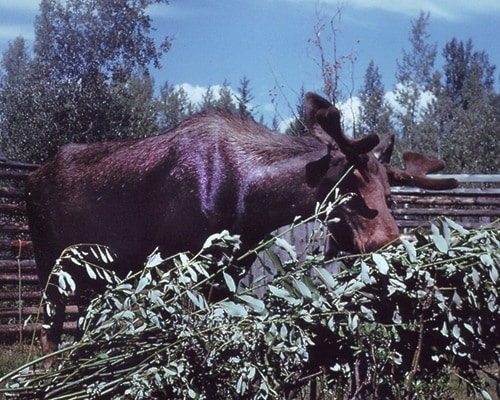Clara Ritcey and Ellen Ferguson
Of the many hundreds of moose that lived in Wells Gray Park in the 1960s, two were a little more special than the rest – and of those two, one wasn’t a Wells Gray Park moose at all.
In the late spring of 1959, Charlie Simpson, a rancher in the Burns Lake area, found a baby moose wandering along the railway tracks. The cow moose had fallen victim to the train.
Charlie took the tiny calf home to his wife Doris, who called him Jerry and raised him on cow’s milk from a bottle. In spite of his inauspicious start in life, Jerry grew quickly and that winter he ate hay beside the ranch cattle. By the following spring he had taken to foraging for twigs and shoots in a nearby swamp, with occasional visits to his old home for company and treats.
At this time, Ralph Ritcey, a Game Branch biologist, was doing research work on moose in Wells Gray Park. Although he had been live-trapping wild moose for the past 10 years, they weren’t particularly cooperative for long-term studies. Fay Hartman, who was working with Ritcey, told him about a yearling moose that had been raised by his friends at Burns Lake. With another co-worker, Herb Green, and a one-ton truck equipped with stock racks, Ritcey headed north.
Jerry, not realizing that he was about to become famous, was nowhere to be seen. Ritcey, Green, and Simpson walked out in the hay field, calling, “Jerry, Jerry.” The young moose, hearing what he was sure was a call of, “Dinner! Come and get it!” raced toward the men.
Having just spent a winter tagging wild moose and dodging angry hooves, Green was not about to stand  there and be trampled. He snatched up a large pole from the ground and, when Jerry got close, smacked him over the head. His enthusiasm somewhat dampened, Jerry was then enticed into the truck with handfuls of fresh leaves and hay. With their unusual passenger, Ritcey and Green headed back to Wells Gray Park and the Hemp Creek Ranger Station, where a large corral would be Jerry’s new home.
there and be trampled. He snatched up a large pole from the ground and, when Jerry got close, smacked him over the head. His enthusiasm somewhat dampened, Jerry was then enticed into the truck with handfuls of fresh leaves and hay. With their unusual passenger, Ritcey and Green headed back to Wells Gray Park and the Hemp Creek Ranger Station, where a large corral would be Jerry’s new home.
Jerry’s diet consisted of bundles of fresh twigs and leaves, supplemented with a special grain mix that had been perfected by biology staff at the University of Alaska.
The bundles of twigs were weighed before being placed in the pen, then any remaining brush was raked up and weighed, to determine exactly how much Jerry had eaten. He had access to all the fresh water he wanted.
It was noted that Jerry would kneel to eat the grain from his feeding pan, the way moose in the wild kneel to reach short brush and grasses.
In 1961, Charlie Simpson came to Wells Gray to check on his moose. Jerry appeared to recognize him, making funny little noises as he ran to meet Simpson. Simpson brought Jerry a head of cabbage as a treat, which Jerry ate with great relish.
The study ended in 1962. Jerry went to the Calgary Zoo where he lived for many years, and where he appeared to enjoy the many visitors who came take photos.
A number of years later, at a meeting of BC Parks managers, the topic of a suitable BC Parks mascot arose. Herb Green suggested Jerry the Moose – and then related the story of his first meeting with Jerry. His wonderfully graphic story-telling ensured that Jerry the Moose is now world famous as the mascot of BC Parks.
Not content with the information gleaned from studying an adult moose, Ritcey was agreeable to a suggestion from Game Branch management that he raise a moose calf, as keeping a record of its food intake and weight gain would be of great value to the study. Unlike studying an adult moose that could live in a pen at the Ranger Station, this project would require the cooperation of Ritcey’s wife, Clara.
Look for the story of Jerry’s cohort, Lippy the Moose, in a future issue of the Times.
